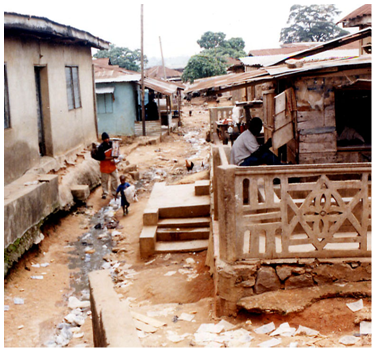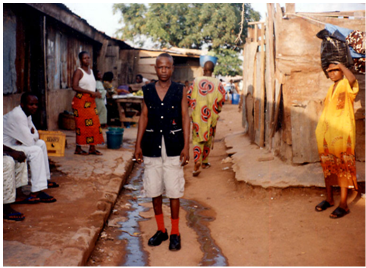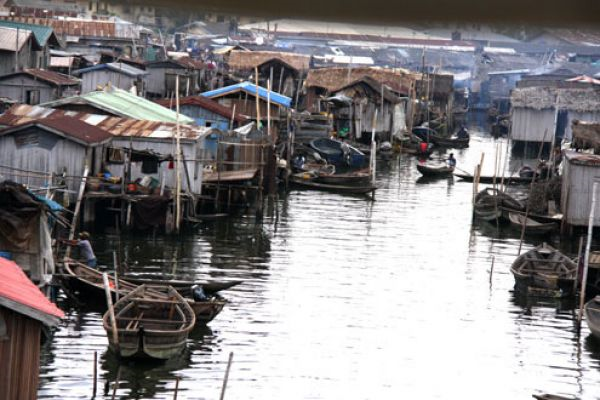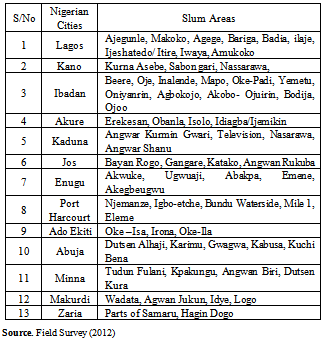-
Paper Information
- Next Paper
- Previous Paper
- Paper Submission
-
Journal Information
- About This Journal
- Editorial Board
- Current Issue
- Archive
- Author Guidelines
- Contact Us
World Environment
p-ISSN: 2163-1573 e-ISSN: 2163-1581
2013; 3(2): 45-51
doi:10.5923/j.env.20130302.02
Slum Prevalence in Nigeria: What Role for Architects?
Sunday A. Bobadoye, Alexander A. Fakere
Department of Architecture, Federal University of Technology, Akure, 340001, Nigeria
Correspondence to: Alexander A. Fakere, Department of Architecture, Federal University of Technology, Akure, 340001, Nigeria.
| Email: |  |
Copyright © 2012 Scientific & Academic Publishing. All Rights Reserved.
Urban decay in Nigeria is essentially caused by rapid urbanization and the mismatch in the provision and maintenance of housing and infrastructure. Most of the housing quality related problems in Nigeria results largely from inadequately planned land use and non-secure land tenure, poverty, poor construction and weak development control. The outcomes are the proliferation of slums which are characterized by overcrowding, flooding, dilapidated structures, existence of stagnant waste water in generally dirty and unhygienic living environments. This paper examines the prevalence of slums in Nigerian cities and outlines useful management inputs. While drawing useful information from approaches to, and successes in city regeneration from some other countries, the paper proposes some professional group input approaches and solutions that can suit local conditions in Nigeria. Specifically, the paper outlines how architects can make significant contributions to slum prevention and control. It posits that regeneration policy; planning and implementation should be inclusive of the input of architects working closely with slum dwellers, administrators and other relevant stakeholders to ensure that occurrences of slums are reduced to the barest minimum.
Keywords: Cities, Environment, Regeneration, Slums, Urbanization
Cite this paper: Sunday A. Bobadoye, Alexander A. Fakere, Slum Prevalence in Nigeria: What Role for Architects?, World Environment, Vol. 3 No. 2, 2013, pp. 45-51. doi: 10.5923/j.env.20130302.02.
Article Outline
1. Introduction
- Slums are home to the poorest of urban populations in Africa. The houses inhabited by slum dwellers are mostly decrepit, overcrowded, in neighbourhoods that are prone to flooding and beset with poor sanitation and shortage of potable water. Urbanization refers to specific changes in the structure and distribution of urban population as well as in size and character of a settlement. Slums are easily formed in areas experiencing rapid urbanisation without commensurate increase in the provision and maintenance of housing and infrastructure. Slums have been conceptualized as a group of buildings or an area characterized by overcrowding, deterioration, insanitary conditions, or absence of basic and essential facilities like potable water, drainage system, schools, health facilities, recreational grounds, post office, among others[8]. Slums generate spontaneously and are in some cases, a direct result of the prevalence of poverty experienced by the inhabitants of cities. Slums, which are regarded as an element of urban decay, also result from congestion in overcrowded cities where poor immigrants seek to settle for just any available accommodation irrespective of quality[14, 15].The overwhelming negatives notwithstanding, there are some positive aspects to slums. In recent years, some environmentalists and organizations such as the United Nations Population Fund suggested that despite the poor living conditions, slums are positive both environmentally and socially. Because slums are characterized by very high density of housing, its environmental impact is smaller than that of dispersed rural communities. Furthermore, the fertility rate of new slum dwellers is below the replacement rate; this mitigates dangers associated with overpopulation that results from manpower-intensive subsistence agriculture, and frees up arable land for the nature, or more efficient industrialized agriculture. Slum dwellers also appear to have vastly better opportunities for getting jobs, starting small businesses and climbing out of poverty than rural inhabitants[6].Nigeria is ranked as one of the countries with high slum prevalence[3]. The proliferation of shanty dwellings, squatter settlements and slums in most of our cities in Nigeria and other less developed nations of the world is attributed to a chain of factors. Of course, such factors are closely associated with the low level of socio-economic and cultural lifestyles of the inhabitants[18]. With a focus on Nigeria, though drawing examples from some countries in Asia and Africa, this paper examines the phenomenon of slums and approaches to its management. A key component of the paper is how architects can contribute significantly to slum prevention and control via the professional and community services media.
2. Slum Prevalence in Nigeria
- The proliferation of slums in Nigeria has been over the years a matter of great concern. As cited by[16], 75% of the dwelling units in urban centres in Nigeria are substandard and the dwellings sited in slums. The inadequacy of the quality of most urban housing stems mainly from the poor physical state of the buildings. They are often unsafe and insecure and do not provide adequate shelter from the elements of weather. The environment in which the buildings are located is squalid in most cases, and this generally leads to slum conditions. Table 1, plates 1 – 5 and figure 1 show the occurrences of slums in some major cities in Nigeria.
|
 | Plate 1. View of the core area of Beere in Ibadan. The high percentage of derelict houses is noticeable at the back of the photo. Source:[7] |
 | Plate 2. Cement houses opposite makeshift wooden houses in Ojoo, Ibadan. Source:[7] |
 | Plate 3. Street in Bodija Market slum. Toilets are on the right, houses, on the left. Source:[7] |
 | Plate 4. Makoko slums and sawmills in Lagos, Nigeria. Source:[10] (accessed 2nd March, 2012) |
 | Plate 5. A waterfront slum in Port Harcourt. Source:[26] (accessed on 2nd March, 2012) |
 | Figure 1. Map of Nigeria showing some Nigerian cities and the spread of slum prevalence. Source: Researchers’ Survey (2012) |
3. Factors Resulting in the Formation of Slums in Nigeria
- There are several factors which contribute to the prevalence of slums in Nigeria. Some of the contributory factors are:
3.1. Scarcity of Lands, Services and Security of Tenure
- The inability of most low income earners to secure cheap plots with services and the prevalence of non-secure tenures invariably breed squatting, congestion and consequently the growth of slums.
3.2. Neglect of Buildings and Their Environment which Makes Them Become Derelict
- A study carried out by[8] posits that the neglect of buildings is largely occasioned by low capital base of the inhabitants. Neglect brings about rapid physical deterioration and consequently, the emergence of slums.
3.3. Poverty and Illiteracy
- The high rate of poverty and illiteracy has also been identified as factors that contribute significantly to the formation of slums in Nigeria. Slum areas are locus ofpoverty where various factors that enhance slum development and growth are noticeable[18],[4]. Low income earnings affect the level of capital formation, which deprives the people of sufficient resources to utilize in improving their homes and keep their environment healthy for comfortable living. This partly explains why six to ten people would live in a room[8].
3.4. Use of sub-standard Building Materials
- The widespread use of sub-standard materials causes rapid deterioration of houses and infrastructure and aid the growth of slums.
3.5. Poor Maintenance Culture
- Poor attitude to the maintenance of buildings and infrastructure is commonplace in Nigeria. Poor maintenance of buildings and public utilities is a major factor which contributes to slum formation.
3.6. Congestion
- Congestion of residential areas is a major factor and a catalyst for the emergence of low environmental quality and insanitary conditions in the urban centres.
3.7. Poor Enforcement of Sanitation Laws
- Many cities in Nigeria do not enforce environmental sanitation laws. This creates waste management problems which is a major problem in many towns and cities especially the slum areas. Also, many houses in Nigerian cities do not have sanitary facilities such as toilets, bathrooms, sewers, etc; hence, human excreta, domestic wastes, and wastewater end up in rivers, streams, canals, gullies, etc untreated, thereby resulting in environmental pollution.Furthermore, weak development control in most urban areas usually culminates in the springing up of squatter settlements which is one of the major characteristics of slums. However, this is not as a result of a lack of laws guiding physical development, but a lack of enforcement of existing laws. Ideally, every neighbourhood should have open spaces for recreation and leisure, but this is always palpably absent in slums. Also, when there is poor development control, people tend to build on drainage lines and this result into flooding.
4. Slum Management
- Slum management essentially entails the prevention, control and upgrading of slums. Slum upgrading and prevention policies have helped reduce prevalence in urban areas[23]. Two basic approaches are most popular in slum management, namely preventive and curative measures[5]. Preventive measures taken to forestall the emergence of slum settlements or at least curtail squatting activity are the most desirable option. Towards this end, efforts should be geared towards checking the development of new slum settlements. Studies suggested two key actions for slum prevention in Owerri, Nigeria. First, provision of cheap land and services for the urban poor; and second, early occupation and adequate monitoring of acquired land to prevent encroachment[19]. However, where a slum settlement has evolved with its associated problems, adopting appropriate curative measures becomes imperative. Nonetheless, cognizance should be taken of the socio-economic implications of the options to be adopted. A World Bank study[22] suggested three options namely; eradicating the slum and relocating residents, clearance and redevelopment; and slum upgrading. Other widely recognized options that may be adopted ranges from rehabilitation, renovation, economic revivification and preservation.
5. The Review of Some Previous Regeneration Programmes in Nigeria
- The wide occurrence of slums in Nigeria cities makes regeneration needful. Consequently, Clean-Up Nigeria, a non-governmental organization embarked on a cleaning up campaign in Ajegunle, Lagos state engaging several unemployed youths in the process. Most of the ghetto, where more than 2 million people live, lies in the swampy estuaries of the Lagos lagoon with a major canal running right through the slum. It lacks proper sewage and garbage collection systems so human, household and vegetable wastes are passed straight into the brackish waters of the lagoon. Several toilets and bathrooms facilities were constructed for the community, the management of which was given over to the some of the youths who participated actively throughout the project. They usually charge money for use of the toilets and bathrooms, a percentage of which they pay into the Clean-up Nigeria Waste Management Co-operative Thrift and Credit Society[2].Similarly, a comprehensive urban renewal programme covering 750 hectares which comprises of nine communities was launched in Lagos state in 2001 based on a World Bank study. One of the blighted communities is Makoko. The project is named “Trunk Infrastructure Delivery” and it is a $200 million World Bank assisted project being presently managed by the State government agency – Lagos Metropolitan Development and Governance Project (LMDGP). The scope of the project includes waste management, potable water supply, drainage services, road construction and rehabilitation and institutional support[9].Furthermore, the Ibadan Metropolitan Planning Authority in collaboration with the Ministry of Lands and Housing, Oyo State decided to embark on the urban renewal of Ibadan in 1998. This project was assisted by World Bank and its major focus was to improve various aspects of housing, living and environmental conditions of different slums in Ibadan. The physical plan consisted mainly in providing street lights, public toilets, tarred roads, drainage; refuse disposal sites and resettlement sites. Some of the areas affected were Mokola and Yemetu/Adeoyo[1].Also, the Rivers State government embarked on the demolition of all slums at the Port-Harcourt waterfronts in 2009. The major reason was due to the fact that the slums had become dens of criminals that constantly terrorize the city. Njemanze settlement, one of the slums demolished by the State government in 2009 has not been redeveloped and had since become a refuse dump. Compensation was however paid to the affected residents[13].
6. Urban Regeneration Efforts: Example from Selected Continents
- In Asia, China and India - the world’s most populous nations, have improved the lives of more slum dwellers than any other country, according to UN-HABITAT’s “State of the World Cities 2010/2011: Bridging the Urban Divide”. Collectively, they have lifted at least 125 million out of slums between 1990 and 2010.The report stated that China’s achievement has been the most impressive, with improvements to the daily conditions of 65.3 million urban residents who were previously deprived of shelter. Proportionally, China’s urban population living in slums fell almost 25% from 37.3% in 2000 to 28.2% in 2010[24]. Furthermore in the report, despite growing inequality due to the country’s rapid economic advance, China has improved living conditions by embracing economic reforms and implementing modernization policies that have used urbanization to drive national growth.India has lifted 59.7 million people out of slum conditions since 2000 and slum prevalence fell about 32% from 41.5% in 1990 to 28.1% in 2010[24]. The report noted that reducing poverty and improving conditions in slums are part of India’s urban development policy and it achieved this in four ways: first, by building the skills of the urban poor in their chosen businesses, and by providing them micro-credit; second, by providing basic services and development within slum settlements, thus improving living conditions; third, by providing security of tenure to poor families living in unauthorized settlements, improving their access to serviced low-cost housing and subsidized housing finance; and fourth, by encouraging the poor to take part in decision-making and community development efforts.The report further stated that in South-East Asia, Indonesia improved the lives of 21.2 million slum dwellers, a 33% proportional decrease from 2000 to 2010 and in the same vein, Vietnam’s slum incidence dropped from 48% in 2000 to some 33.7% in 2010 – a 30% reduction. This is commensurate with poverty reduction over the same period, and Vietnam has also made significant progress on most of the other Millennium Development Goals[24].In Africa, Morocco has moved 2.4 million out of slum conditions over the past 10 years, a 45.8% reduction in slum prevalence due to strong political leadership, clear targets and adequate budget resources[24]. In the same vein, Egypt reduced its proportion of slum dwellers by 39%; slum prevalence fell by 28.1% of the urban population in 2000 to some 17.1% in 2010: in absolute numbers, the Government of Egypt improved the living conditions of five million people[24].
7. Suggested Way Forward for Nigerian Slums
- Several studies have been carried out in the past in the regeneration of slums of some Nigerian cities. In order to improve the life of the poor in deplorable parts of urban centres through physical planning,[15] carried out a study and suggested, with particular reference to Akure that urban renewal in form of rehabilitation and upgrading programme will be suitable. This is by way of providing the essential facilities and revive the outdated ones rather than embarking on total clearance and redevelopment that can affect the residents negatively. The first step in this approach is to ensure security of tenure for the property owners. When the fear of perpetual ejection is removed, property owners will now be interested to invest in the improvement of their houses and environment[5]. According to a World Bank report, upgrading rejuvenates the existing community with minimum disruption and loss of physical and social assets[22].Also, in some studies of the slum areas of Akure, rehabilitation and renovation as well as provision of urban basic services was recommended as part of an upgrading programme. This involves rejuvenation of affected parts of the area; rehabilitate old buildings and structures, upgrading the roads that are not asphalted and the introduction of more roads with a view to opening up the blighted areas. It also involves improvement of existing infrastructures as well as provision of new ones. All these are geared towards improving the structural quality and aesthetic of the areas. It was also suggested that the generation of employment opportunities, otherwise known, as economic revitalization is highly needed in the area. This will help to improve the level of capital base and potential for capital formation among the residents that will enhance the level of provision for basic household facilities and proper maintenance of buildings[14],[15],[18]. Eradicating and relocating of slums has been described as a failed response of the 1960s and 1970s by the World Bank[22]. However, in Nigeria, the slum dwellers are ejected and their property which are described as illegal structures are demolished. This is a worst case scenario. The several demolition exercises in Abuja and that of the entire Maroko settlements in 1991 are typical examples. Ejection of squatters and demolition of illegal structures generates social, economic and political problems with their attendant security implications[5]. It tends to portray government as insensitive to the plight of the citizenry. The ultimate result has been the loss of these dwellings and the dispersal of the populations either into new slums or to swell the ranks of the existing slums while the area is being laid out and allocated for high class residential development[17]. Demolition also results in financial losses both to the squatters and the government; and depletes the national housing stock[11].In another study[5], clearance and redevelopment was suggested as a curative approach. This involves a temporary movement of the residents while the site is being cleared and new structures, usually high rise buildings erected for them on the same site. This approach involves high social and economic costs which are almost unaffordable. Besides, the developments of high rise buildings will not provide sufficient ground level spaces which are needed by these low income families to operate their small businesses which they use to augment their meagre incomes.Although some have suggested an enforcement of environmental laws on citizens, nevertheless, there will be just a little prospect of success without an enlightened public[20],[21]. The starting point therefore is to educate the people on the dangers of poor sanitation on their health and the need for an improved healthy environment. This approach is prudential and can sustain improvement efforts that may be put in place to revive the area. Similar to this is the use of effective public enlightenment strategies to affect public awareness and community participation in area of personal hygiene and need for improving sanitary condition in the area[18]. Whatever the method being adopted, the planning and implementation should involve the community with the motive of sustainable development.
8. How Architects Can Contribute to Slum Prevention and Control
8.1. The Micro Level – the Professional Practice Sphere
- 1). Entrenching a culture of sound design decisions which arises from a thorough and effective design management process. Ensuring that design decisions and actions culminate into proposals that conform strictly to stipulated bye-laws and at the same time, meets global best practices. This will contribute to building liveable neighbourhoods and reduce the prevalence of slums.2). Spearheading world class but locally appropriate proposals for low income communities in urban centres. This refers to designs and construction premised on the use of local materials and renewable energy[green building]. The core[growing] house design, built with low cost but durable materials like stabilized laterite, seasoned timber and bamboo will make decent housing possible for the urban poor and thus reduce the prevalence of slums. Nigeria receives abundance sunshine throughout the year. Architects should therefore come up with designs of solar dependent houses with roofs configured to bear solar panels. This will provide a platform for provision of cheap but clean energy to power homes and thus reduce dependence on scarce hydro resources and fossil fuels to provide electrical energy. As comprehensively documented by[12], a Nigerian architect, Kunle Adeyemi, has set out to construct a three-story school out of 16 floating platforms on the murky waters of Makoko slum in order to alleviate the sufferings of the slum dwellers. The project involves building the platforms out of locally sourced materials.3). Deployment of cutting-edge expertise in the management of construction projects: Architects should constantly ensure they are positioned at the frontiers of project management practice through training and retraining. This will position the profession to provide timely solutions to the various challenges associated with slum redevelopment projects.
8.2. The Macro level – The Community Development Sphere
- 1). Helping to develop and sustain the policy and practice of community participation: Architects have the role of ensuring ‘design with low income earners’ as opposed to ‘design for low income earners’ in slum upgrading projects. In the context of designing for low income earners, the architect assumes knowledge of what the poor need. However, designing with low income earners requires active participation of target low income groups in designing their houses and neighbourhoods.2). Rejuvenation and sustaining the ‘free house plan for Nigerians’ model of the Nigerian Institute of Architects: The free house plan scheme was put into operation in the 80’s and 90’s with varying level of awareness and utilisation across the country. There is now the need, more than ever before, to redesign and give it widespread publicity.3). Helping to improve water supply and sanitation in low income neighbourhoods: This requires facilitating the sinking of boreholes and construction of community toilets in slum areas as forms of community service by individuals or groups of architects or in partnership with corporate organisations.
9. Conclusions
- Slum prevention and control is vital to creating sustainable cities. Also, slums eradication is a vital component of the millennium development goals. The important role of architects in slum prevention and control has been highlighted in this paper. In addition to the foregoing discuss, architects can feature in commissioned or non commissioned advocacy for communities. In this role, they work to match the needs of communities with efforts of government and non governmental agencies. From the perspectives of professional and community services, the living circumstances of slum dwellers requires the constant focus of architects with a view to fashioning ways of improving their wellbeing and productivity.
 Abstract
Abstract Reference
Reference Full-Text PDF
Full-Text PDF Full-text HTML
Full-text HTML